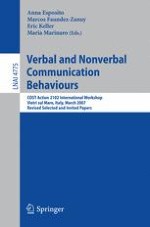This volume brings together the invited papers and selected participants’ contributions presented at the COST 2102 International Workshop on “Verbal and Nonverbal Communication Behaviours”, held in Vietri sul Mare, Italy, March 29–31, 2007. The workshop was jointly organized by the Faculty of Science and the Faculty of Psychology of the Second University of Naples, Caserta, Italy, and the International Institute for Advanced Scientific Studies “Eduardo R. Caianiello”(IIASS), Vietri sul Mare, Italy. The workshop was a COST 2102 event, and it was mainly sponsored by the COST (European Cooperation in the Field of Scientific and Technical Research) Action 2102 in the domain of Information and Communication Technologies (ICT), as well as by the above-mentioned organizing Institutions. The main theme of the workshop was to discuss the fundamentals of verbal and nonverbal communication features and their relationships with the identification of a person, his/her socio-cultural background and personal traits. In the past decade, a number of different research communities within the psychological and computational sciences have tried to characterize human behaviour in face-to-face communication by several features that describe relationships between facial, prosodic/voice quality, formal and informal communication modes, cultural differences, individual and socio-cultural variations, stable personality traits and degrees of expressiveness and emphasis, as well as the individuation of the interlocutor’s emotional and psychological states.
